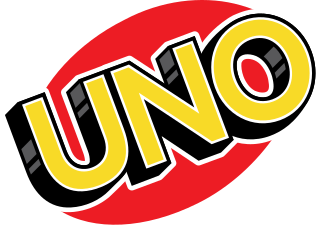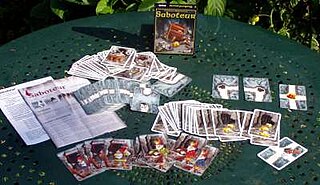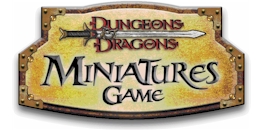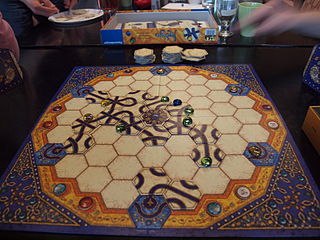
Dominoes is a family of tile-based games played with gaming pieces. Each domino is a rectangular tile, usually with a line dividing its face into two square ends. Each end is marked with a number of spots or is blank. The backs of the tiles in a set are indistinguishable, either blank or having some common design. The gaming pieces make up a domino set, sometimes called a deck or pack. The traditional European domino set consists of 28 tiles, also known as pieces, bones, rocks, stones, men, cards or just dominoes, featuring all combinations of spot counts between zero and six. A domino set is a generic gaming device, similar to playing cards or dice, in that a variety of games can be played with a set. Another form of entertainment using domino pieces is the practice of domino toppling.

Mahjong or mah-jongg is a tile-based game that was developed in the 19th century in China and has spread throughout the world since the early 20th century. It is played by four players. The game and its regional variants are widely played throughout East and Southeast Asia and have also become popular in Western countries. The game has also been adapted into a widespread online entertainment. Similar to the Western card game rummy, mahjong is a game of skill, strategy, and luck. To distinguish it from mahjong solitaire, it is sometimes referred to as mahjong rummy.

Uno, stylized as UNO, is a proprietary American shedding-type card game originally developed in 1971 by Merle Robbins in Reading, Ohio, a suburb of Cincinnati, that housed International Games Inc., a gaming company acquired by Mattel on January 23, 1992.

Carcassonne is a tile-based German-style board game for two to five players, designed by Klaus-Jürgen Wrede and published in 2000 by Hans im Glück in German and by Rio Grande Games and Z-Man Games (currently) in English. It received the Spiel des Jahres and the Deutscher Spiele Preis awards in 2001.
NECA/WizKids, LLC is an American company based in New Jersey that produces tabletop games. WizKids is best known for its collectible miniatures games (CMGs) Mage Knight, HeroClix, MechWarrior, and HorrorClix, all of which make use of the company's Clix system, in which the changing combat statistics and abilities of each figure were indicated by a turnable dial inside the base underneath the figure. The company was founded in 2000 by Jordan Weisman, a veteran of the game company FASA. It was purchased by sports-card manufacturer Topps, Inc. in 2003.
The Black Path Game is a two-player board game described and analysed in Winning Ways for your Mathematical Plays. It was invented by Larry Black in 1960.

Trax is a two-player abstract strategy game of loops and lines invented by David Smith in 1980.
In tabletop games and video games, game mechanics are the rules or ludemes that govern and guide the player's actions, as well as the game's response to them. A rule is an instruction on how to play, a ludeme is an element of play like the L-shaped move of the knight in chess. A game's mechanics thus effectively specify how the game will work for the people who play it.
Scrabble variants are games created by changing the normal Scrabble rules or equipment.
Wiz-War is a 4-player board game created by Tom Jolly and first published in 1985 through Jolly’s company, Jolly Games. It is described as a "beer and pretzels game".

Take It Easy is an abstract strategy board game created by Peter Burley. It can be characterized as a strategic bingo-like game, and has been published by Ravensburger and subsequently by several other publishers since 1983.
Carcassonne: The City is a German board game for two to four players. As a member of the Carcassonne family of games, it is created by Klaus-Jürgen Wrede and distributed by Hans im Glück in German and Rio Grande Games in English. Like other Carcassonne games, the objective of the game is to score points based on placement of the tiles. However, The City also adds city walls and towers, which can inhibit the growth of the playing field in a certain direction. The City is packaged in a "deluxe" manner: the box itself is made from wood, as are the parts for the city walls, followers, and towers.

Crosstrack, billed as the "unique track switching game", is an abstract strategy game designed by Philip Shoptaugh and first published in 1994. Players place special track pieces onto an irregular octagon board, winning by being the first to create an unbroken path between two opposite sides. It is an example of a tile-based edge-matching path connection game, similar to the Black Path Game, Trax, and Tsuro, Tantrix and Kaliko, and Octiles.
A connection game is a type of abstract strategy game in which players attempt to complete a specific type of connection with their pieces. This could involve forming a path between two or more endpoints, completing a closed loop, or connecting all of one's pieces so they are adjacent to each other. Connection games typically have simple rules, but complex strategies. They have minimal components and may be played as board games, computer games, or even paper-and-pencil games.
Oceania is a board game by Klaus Teuber, published by Mayfair Games. It is a simpler version of Entdecker, and is played with one or two players. The solitaire version's objective is completely different from the two player version's.

Saboteur is a mining-themed card game, designed by Frederic Moyersoen and first published in 2004.

The Dungeons & Dragons Miniatures Game is a collectible miniatures game played with pre-painted, plastic miniature figures based on characters and monsters from the Dungeons & Dragons game. The figures are 30mm in scale. Produced by Wizards of the Coast, the Dungeons & Dragons Miniatures line is composed of 20 loosely themed sets that were released roughly every four months since the line was launched in 2003 until its cancellation in 2011.

Indigo is a 2012 tile-laying board game developed by Reiner Knizia and published by Ravensburger.
Serpentiles is the name coined by Kurt N. Van Ness for the hexagonal tiles used in various edge-matching puzzle connection abstract strategy games, such as Psyche-Paths, Kaliko, and Tantrix. For each tile, one to three colors are used to draw paths linking the six sides together in various configurations. Each side is connected to another side by a specific path route and color. Gameplay generally proceeds so that players take turns laying down tiles. During each turn, a tile is laid adjacent to existing tiles so that colored paths are contiguous across tile edges.

The first season of The Challenge: All Stars premiered on Paramount+ on April 1, 2021. The season featured twenty-two cast members from The Real World, Road Rules and The Challenge competing for $500,000.


















































